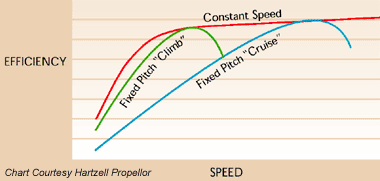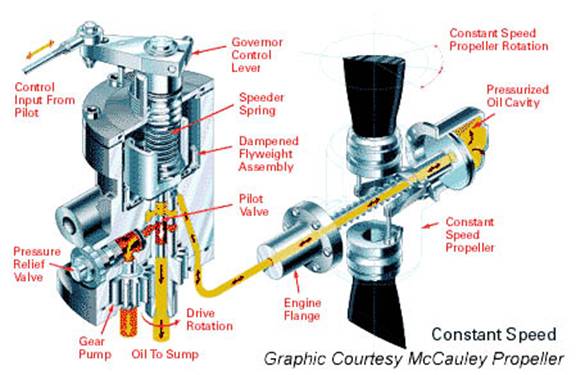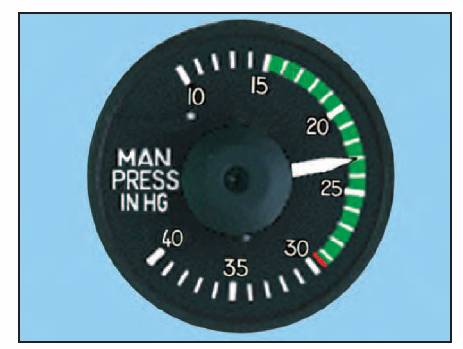G-LGCA is fitted with a Hoffman 3 blade variable pitch propeller. This constitutes a complex type and differences training is required before flying the variant. The following notes give an explanation of the workings and operation of this type of propeller. A reasonable knowledge of how the unit works and it's basic operation will be helpful before receiving a more thorough briefing and aircraft training.
 Figure
1
Figure
1
VARIABLE-PITCH PROPELLER
Although some older variable-pitch propellers could only be adjusted on the ground, most modern variable-pitch propellers are designed so that you can change the propeller pitch in flight. The first variable-pitch propeller systems provided only two pitch settings; a low-pitch setting and a high-pitch setting. Today, however, nearly all variable-pitch propeller systems are capable of a range of pitch settings.
A constant-speed propeller is the most common type of variable-pitch propeller and this is the type fitted to “CA”. The main advantage of a constant-speed propeller is that it converts a high percentage of brake horsepower (BHP) into thrust horsepower (THP) over a wide range of r.p.m. and airspeed combinations. A constant-speed propeller (see figure 1) is more efficient than other propellers because it allows selection of the most efficient engine r.p.m. for the given conditions.
An airplane with a constant-speed propeller has two controls—the throttle and the propeller control. The throttle controls power output, and the propeller control regulates engine r.p.m. and, in turn, propeller r.p.m., which is registered on the tachometer. Once a specific r.p.m. is selected, a governor automatically adjusts the propeller blade angle as necessary to maintain the selected r.p.m. For example, after setting the desired r.p.m. during cruising flight, an increase in airspeed or decrease in propeller load will cause the propeller blade angle to increase as necessary to maintain the selected r.p.m. A reduction in airspeed or increase in propeller load will cause the propeller blade angle to decrease.

Figure 2. Schematic of a typical constant speed unit.
The range of possible blade angles for a constant-speed propeller is the propeller's constant-speed range and is defined by the high and low pitch stops. As long as the propeller blade angle is within the constant-speed range and not against either pitch stop, a constant engine r.p.m. will be maintained. However, once the propeller blades contact a pitch stop, the engine r.p.m. will increase or decrease as appropriate, with changes in airspeed and propeller load. For example, once a specific r.p.m. has been selected, if aircraft speed decreases enough to rotate the propeller blades until they contact the low pitch stop, any further decrease in airspeed will cause engine r.p.m. to decrease the same way as if a fixed-pitch propeller were installed. The same holds true when an airplane equipped with a constant-speed propeller accelerates to a faster airspeed. As the aircraft accelerates, the propeller blade angle increases to maintain the selected r.p.m. until the high pitch stop is reached. Once this occurs, the blade angle cannot increase any further and engine r.p.m. increases.
On airplanes that are equipped with a constant-speed propeller, power output is controlled by the throttle and indicated by a manifold pressure gauge. The gauge (figure 3) measures the absolute pressure of the fuel/air mixture inside the intake manifold and is more correctly a measure of manifold absolute pressure (MAP) . At a constant r.p.m. and altitude, the amount of power produced is directly related to the fuel/air flow being delivered to the combustion chamber. As you increase the throttle setting, more fuel and air is flowing to the engine; therefore, MAP increases. When the engine is not running, the manifold pressure gauge indicates ambient air pressure (i.e., 29.92 in. Hg). When the engine is started, the manifold pressure indication will decrease to a value less than ambient pressure (i.e., idle at 12 in. Hg). Correspondingly, engine failure or power loss is indicated on the manifold gauge as an increase in manifold pressure to a value corresponding to the ambient air pressure at the altitude where the failure occurred.

Figure 3. Engine power output is indicated on the manifold pressure gauge.
For any given r.p.m., there is a manifold pressure that should not be exceeded. If manifold pressure is excessive for a given r.p.m., the pressure within the cylinders could be exceeded, thus placing undue stress on the cylinders. If repeated too frequently, this stress could weaken the cylinder components, and eventually cause engine failure.
You can avoid conditions that could overstress the cylinders by being constantly aware of the r.p.m., especially when increasing the manifold pressure. Conform to the manufacturer's recommendations (see below) for power settings of the Lycoming engine so as to maintain the proper relationship between manifold pressure and r.p.m. When both manifold pressure and r.p.m. need to be changed, avoid engine overstress by making power adjustments in the proper order:
• When power settings are being decreased , reduce manifold pressure before reducing r.p.m. If r.p.m. is reduced before manifold pressure, manifold pressure will automatically increase and possibly exceed the manufacturer's tolerances.
• When power settings are being increased , reverse the order—increase r.p.m. first, then manifold pressure.
SoDECREASE
POWER |
MAP then PROP |
|---|---|
INCREASE POWER |
PROP then MAP |
As a general rule; MAP should not exceed PROP by more than “2”.
For example;
2700
rpm 29” MAP |
OK
and a typical take-off value |
|---|---|
2500 rpm 27” MAP |
OK |
2500 rpm 25” MAP |
OK and a typical initial
climb value |
2300 rpm 15” MAP |
OK and would represent
a shallow descent |
2300 rpm 26” MAP (or more) |
OVERBOOST
situation and MUST be avoided |
Manifold Absolute Pressure (MAP)—The absolute pressure of the fuel/air mixture within the intake manifold, usually indicated in inches of mercury ( in. Hg) or (“). |
|---|
Governor Failure
The constant-speed prop used on “CA” uses a very powerful internal spring to drive the blades to fine pitch, with governor oil pressure used to oppose that force.
The normal aerodynamic force on any airfoil tends to pitch it down (to a lesser angle of attack). Props are no exception, since they are rotating airfoils. Aerodynamic forces tend to drive all props to the fine pitch position.
In either case, a governor failure causes the prop simply to go to fine pitch, whereupon it becomes just another fixed-pitch prop albeit a fine pitch one. The aircraft can be flown safely in this condition.
Robin May
12th March 2004